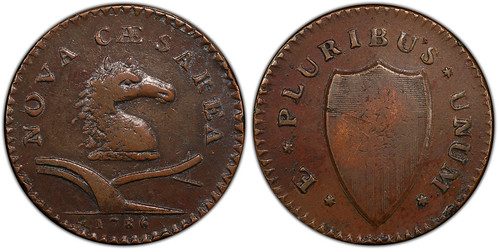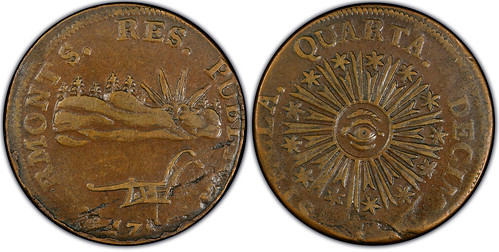
PREV ARTICLE
NEXT ARTICLE
FULL ISSUE
PREV FULL ISSUE
PCGS REDEFINES CONFEDERATION-ERA COPPER COINSPCGS has decided to label a series of early American Colonial coins on its slabs as "halfpennies." -Editor
Professional Coin Grading Service (www.PCGS.com) is officially redefining a series of early American Colonial coins widely categorized by their state names and copper composition with numismatically correct references to their original denominations. The move recategorizes confederation-period New Jersey, Vermont, and Connecticut coins as well as other pieces, such as Immune Columbia and Nova Constellatios, colloquially dubbed
Researchers acknowledge it is clearly evident in state assembly documents of the period from New Jersey, Vermont, and Connecticut that the confederation-era copper coinage was designed as weight- and standard-based equivalents to the British halfpenny coinage, then nicknamed
Sabin cited that, in a similar vein, the current widespread use of the slang term A team of PCGS and industry experts has presented their many findings in a detailed article on PCGS.com that explains not just the reasoning behind this nomenclature change but also the myriad historical facts supporting it.
To read the complete article, see:
Here's an excerpt from the research article by Craig Sholley, John Dannreuther, Jeff Rock, William Eckberg, Chris McCawley, and Brian Greer. -Editor
Many of the Confederation-period copper coins, including the Connecticut, New Jersey, and Vermont state coinages, along with private issues such as the Nova Constellatio, Immune Columbia, and
By the 1850s, the volume of federal cents in circulation resulted in the Connecticut, New Jersey, and New York
Common names are often used for coins. Current auction catalogs use
The lack of a recognized denomination has also caused a good deal of confusion in referring to these pieces. There is no denomination shown in major reference books, such as A Guide Book of United States Coins (widely known as
With that in mind, this article presents evidence that the intended denomination of these
We urge the numismatic community to restore the correct denomination of half penny, using
Since these pieces (and other period coinage) are most certainly NOT colonial coins, we further urge the community to consider moving references to these coins under a category such as
It would be proper for the auction companies to likewise use the proper denomination, but not absolutely necessary as the slang term
To read the complete article, see:
We'll be hearing more about this topic in the near future. As I was about to publish tonight, this submission arrived. -Editor
Recently, an article appeared that asserts that state coppers of the confederation era
should be denominated as halfpence. This is a controversial article and one of the authors has
already disavowed the work and requested his name be removed, while another of the listed
authors was unaware his name was to be appended to the piece and struggles to defend its
conclusions. A group of colonial numismatic scholars will prepare a formal repudiation of this
conclusion for the June issue of the Journal of Early American Numismatics. The consensus of
these colonial coin experts, who have studied these coins for decades and written books and
articles on them, is that they are officially and customarily termed These coins arose during the period between the end of the Revolutionary War and the adoption of our current federal constitution when some states minted copper coins for the use and convenience of their citizens and merchants as small change. They were issued, not as replacements for British halfpence, but to give authority and control to the new states in opposition to the British halfpence. To give all these pieces the same arbitrary value is misleading. A Connecticut copper did not have the same value in commerce as a New Jersey copper; if it did, New Jersey coppers would not sometimes be found overstruck on Connecticuts. The overstriking of these pieces and others, clearly demonstrates that they had different, and variable, values in commerce. In 1787, the New Haven Mint, which had federal and state contracts to mint copper coins, took the federal copper provided by the U.S. Government to mint Fugios and used it to strike Connecticut coppers because they traded at a higher value than Fugios per their copper content.
Most state coppers were a commodity that acted like tokens; from one day to the next,
they might have a different accepted value in commerce. In large transactions, they were sold in
kegs by weight. These coppers did not have a denomination on them, and many of the issues
(New Jersey coppers excepted) were not legal tender; and could not be used in the payment of
taxes or legal obligations. Only a fool in 1788 would trade a gold coin for coppers. The
designation of
Christopher R. McDowell,
Wayne Homren, Editor The Numismatic Bibliomania Society is a non-profit organization promoting numismatic literature. See our web site at coinbooks.org. To submit items for publication in The E-Sylum, write to the Editor at this address: whomren@gmail.com To subscribe go to: https://my.binhost.com/lists/listinfo/esylum All Rights Reserved. NBS Home Page Contact the NBS webmaster 
|


